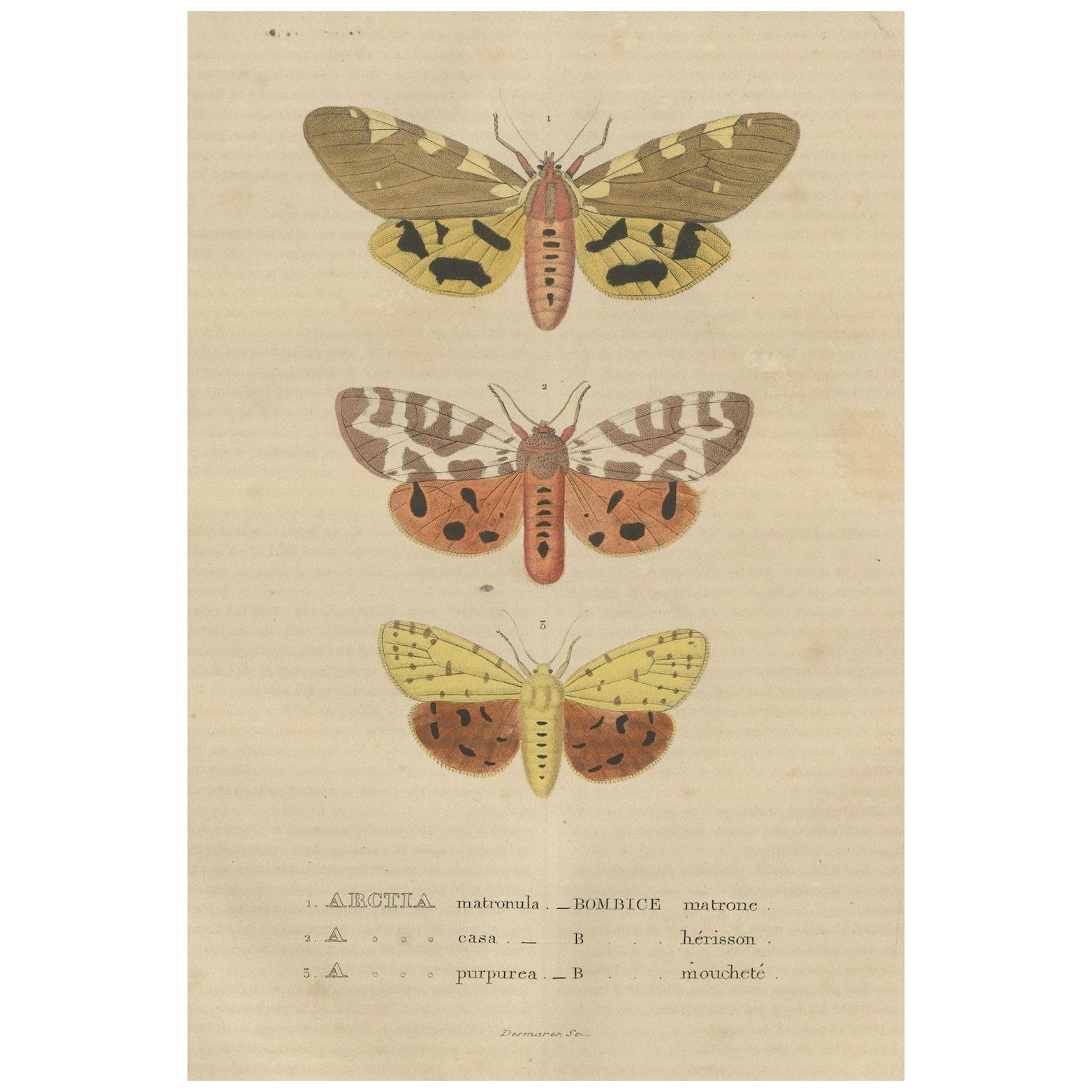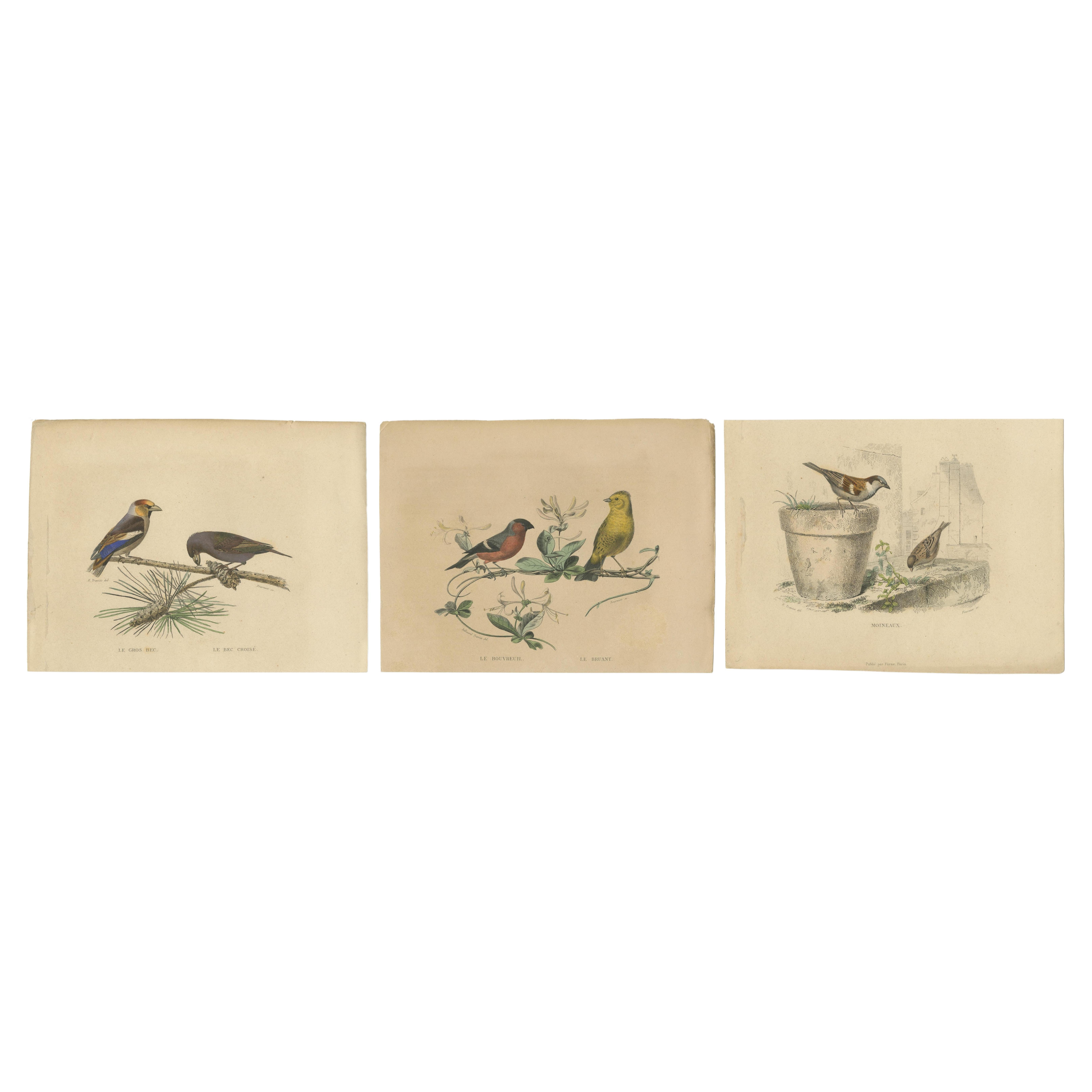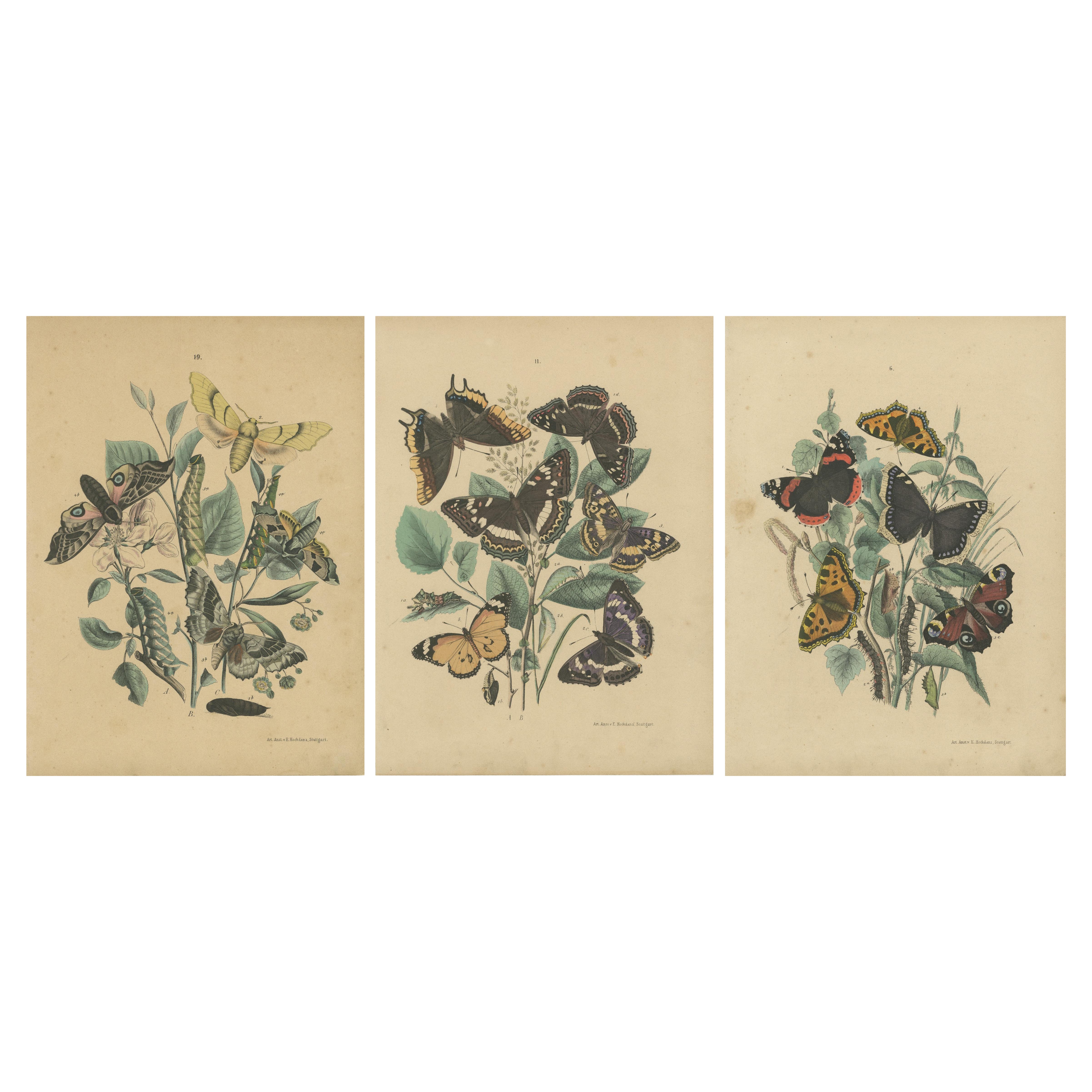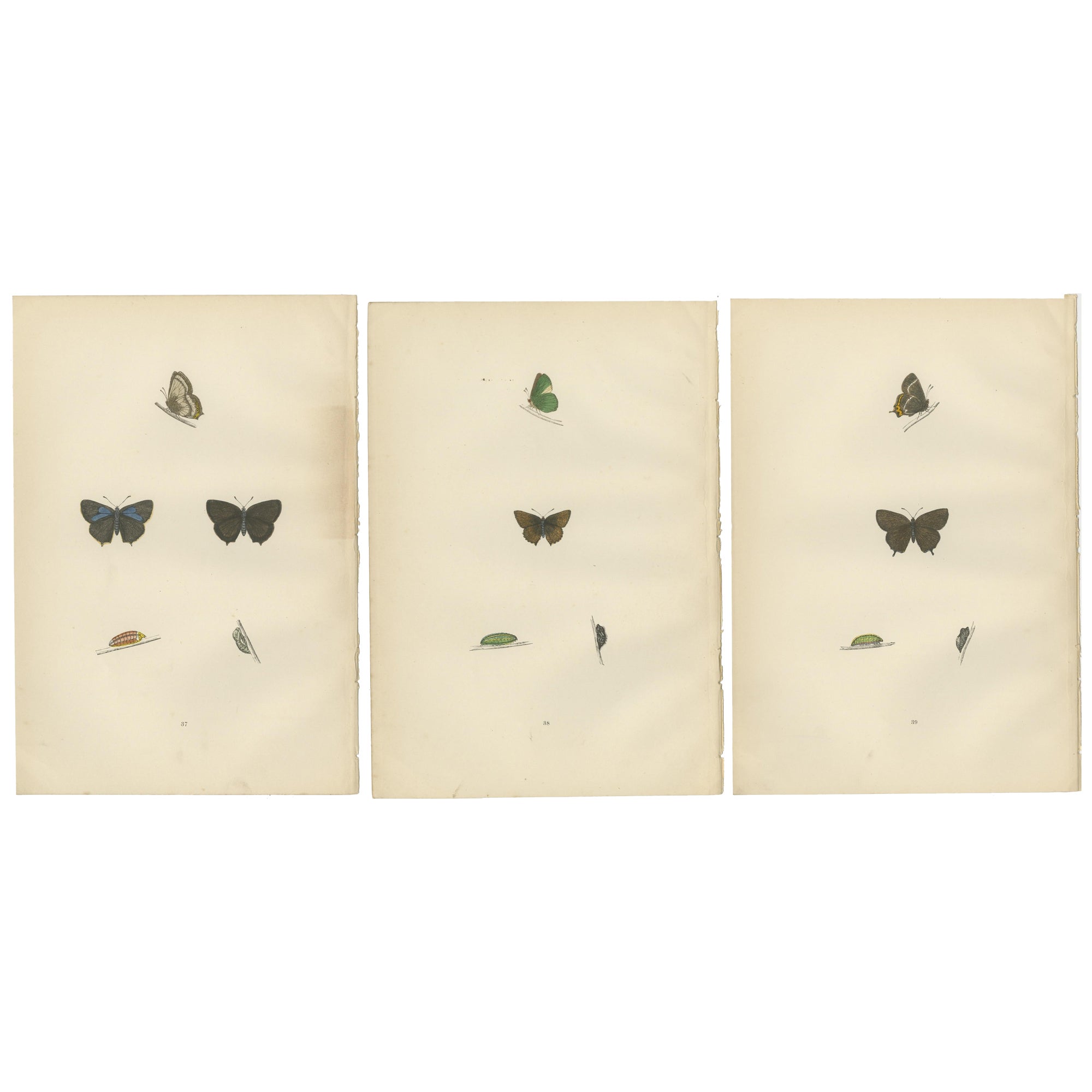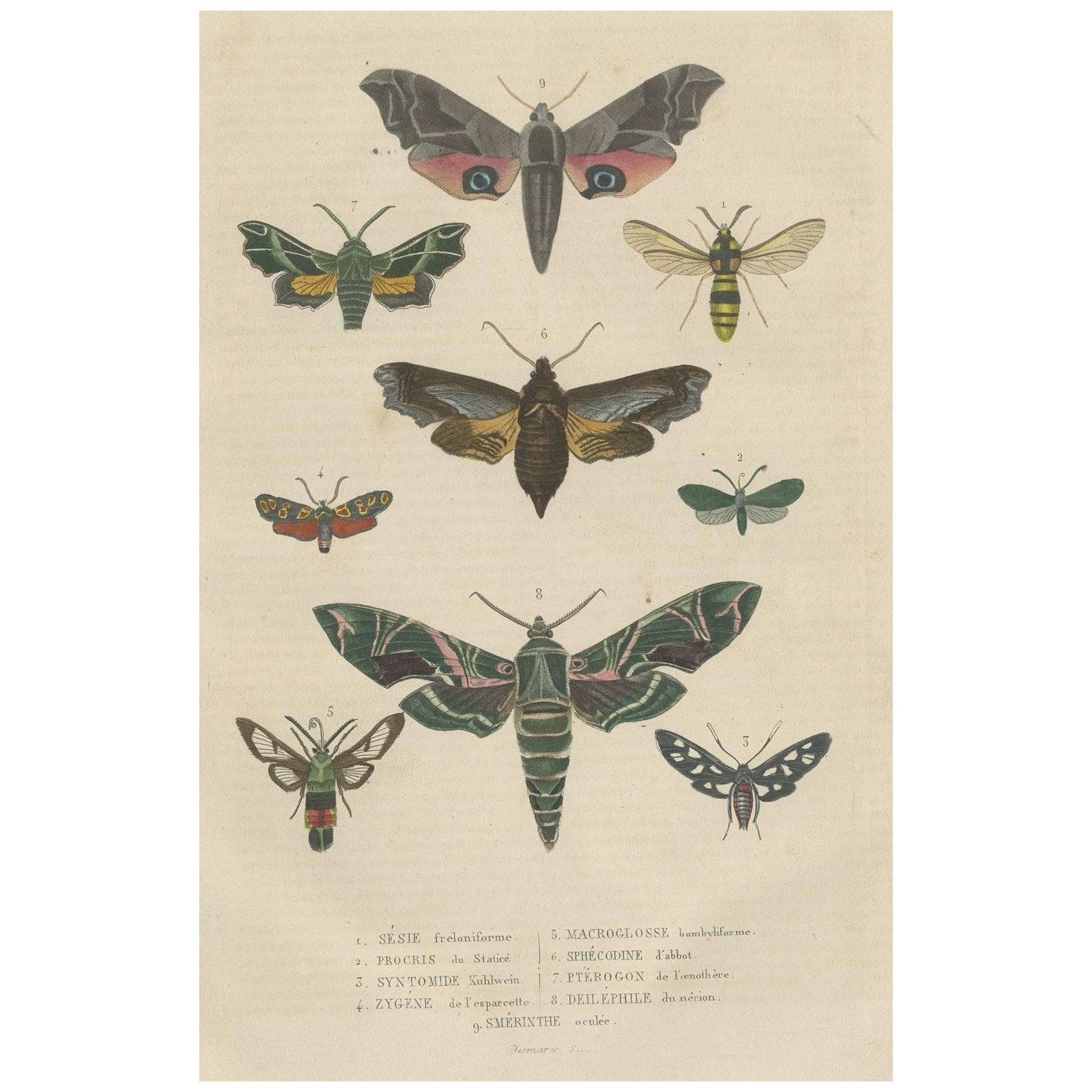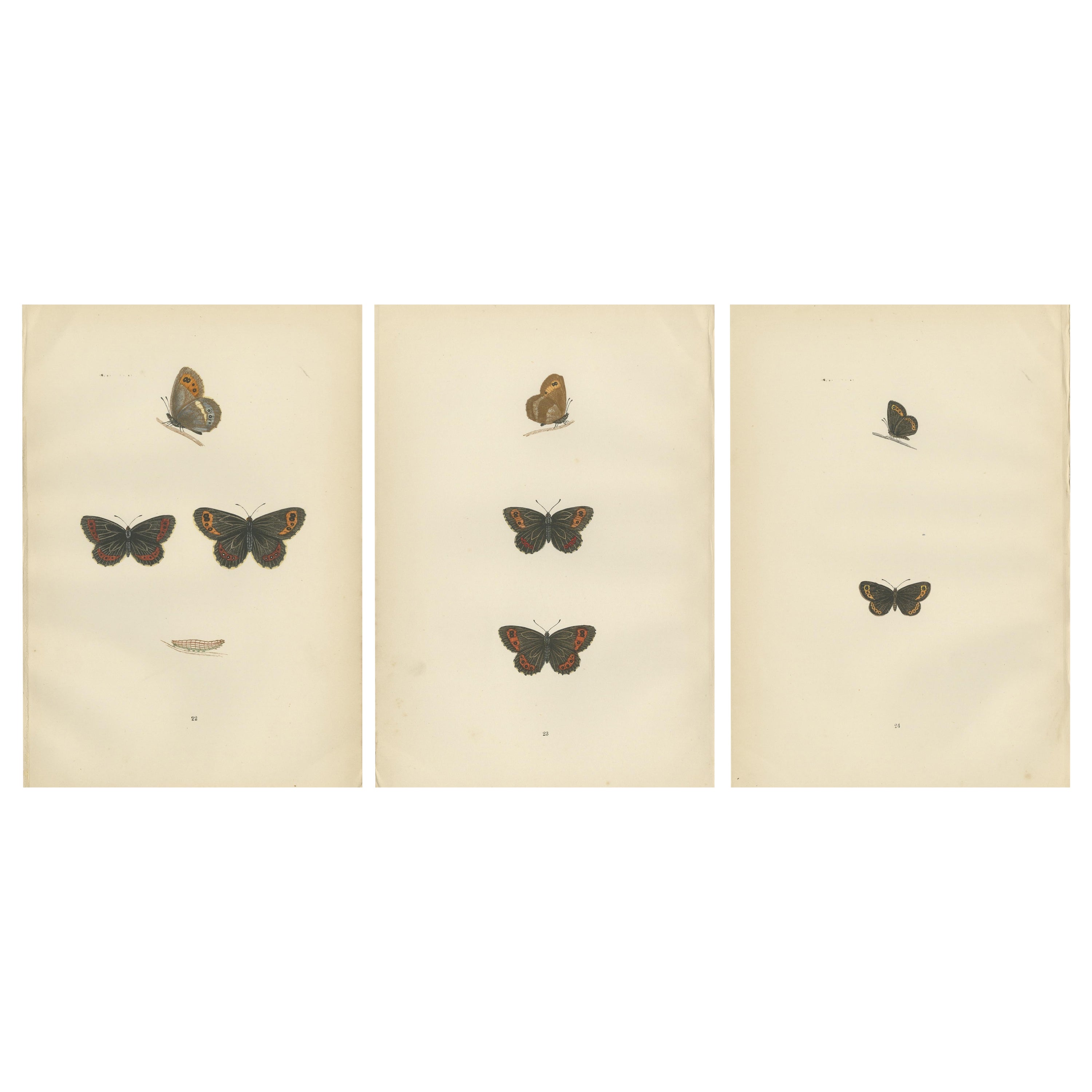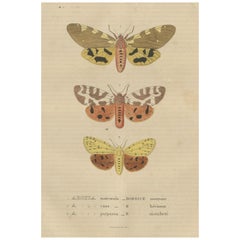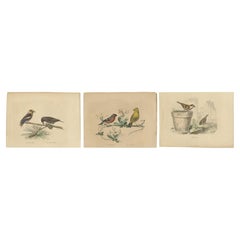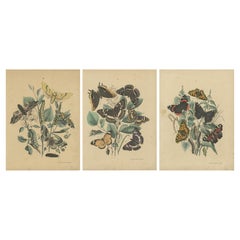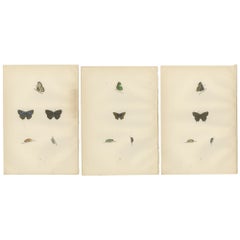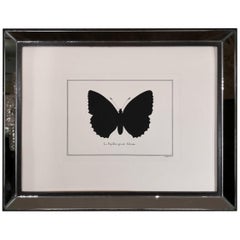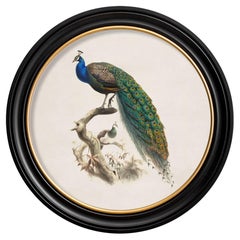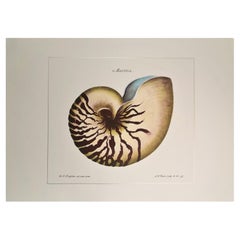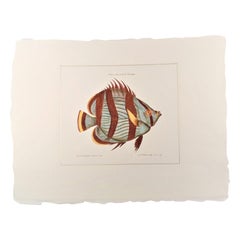Items Similar to British Handcolored Lepidoptera: Treasures from A History of British Butterflies
Want more images or videos?
Request additional images or videos from the seller
1 of 6
British Handcolored Lepidoptera: Treasures from A History of British Butterflies
About the Item
The hand-colored plates from the sixth edition of "A History of British Butterflies" by Morris are exquisite examples of Victorian natural history illustration. Here's a description of the butterflies named:
1. **Silver-Studded Blue (Plebejus argus):** This butterfly is most likely depicted with a blue ground color speckled with silver studs or spots on the underside of the hindwings, which resemble droplets of dew - a feature that gives the butterfly its name. These spots are metallic and reflect light, which is quite unusual and attractive. The Silver-Studded Blue is a species of conservation interest because it requires specific habitats, usually heathland, and has declined in some areas due to habitat loss.
2. **Common Blue (Polyommatus icarus):** The Common Blue is often depicted with vibrant blue upper wings with a white fringe and black edges. The males are typically more brightly colored than the females. This species is widespread and is the most common and widespread blue butterfly in the UK. What makes the Common Blue interesting is its adaptability to a wide range of habitats, including grasslands, woodland clearings, and even urban areas, and it can have several broods in a year depending on the climate.
3. **Chalkhill Blue (Lysandra coridon),** which might be referred to as the Clifton Blue in some historical texts: This butterfly has pale blue, almost powdery wings with black-bordered white margins. The Chalkhill Blue is noteworthy for its specific habitat requirements - it typically resides in chalk downlands. The caterpillars feed on horseshoe vetch, and the adults are often seen absorbing minerals from the ground. This species has been affected by changes in agricultural practices, making its conservation important.
These illustrations not only serve scientific purposes in identifying and documenting species but also are beautiful works of art in their own right. The fact that they are hand-colored adds a personal touch that is often missing from modern printed works. Morris's publication is valuable for understanding the biodiversity of the era and the historical context of natural history study.
- Dimensions:Height: 10.01 in (25.4 cm)Width: 6.82 in (17.3 cm)Depth: 0 in (0.02 mm)
- Materials and Techniques:
- Period:
- Date of Manufacture:1890
- Condition:Condition: Good given age, general age-related toning. Some small spots.. Please study scan carefully.
- Seller Location:Langweer, NL
- Reference Number:Seller: BG-13260-61, BG-13260-62, BG-13260-631stDibs: LU3054338980072
About the Seller
5.0
Recognized Seller
These prestigious sellers are industry leaders and represent the highest echelon for item quality and design.
Gold Seller
Premium sellers maintaining a 4.3+ rating and 24-hour response times
Established in 2009
1stDibs seller since 2017
2,452 sales on 1stDibs
Typical response time: <1 hour
- ShippingRetrieving quote...Shipping from: Langweer, Netherlands
- Return Policy
Authenticity Guarantee
In the unlikely event there’s an issue with an item’s authenticity, contact us within 1 year for a full refund. DetailsMoney-Back Guarantee
If your item is not as described, is damaged in transit, or does not arrive, contact us within 7 days for a full refund. Details24-Hour Cancellation
You have a 24-hour grace period in which to reconsider your purchase, with no questions asked.Vetted Professional Sellers
Our world-class sellers must adhere to strict standards for service and quality, maintaining the integrity of our listings.Price-Match Guarantee
If you find that a seller listed the same item for a lower price elsewhere, we’ll match it.Trusted Global Delivery
Our best-in-class carrier network provides specialized shipping options worldwide, including custom delivery.More From This Seller
View AllHandcolored Variations of Moths: A Study in Lepidoptera Elegance, 1845
Located in Langweer, NL
An original handcolored antique print featuring a series of illustrations of moths. Each moth is meticulously detailed, showcasing a variety of wing patterns and colors. The visual s...
Category
Antique 1840s Prints
Materials
Paper
$176 Sale Price
20% Off
Free Shipping
Avian Treasures from Buffon's Natural History: Hand-Colored Masterpieces, 1837
Located in Langweer, NL
Original hand-colored engravings from around 1837. They are from Buffon's "Natural History of Animals" books. The designer of these beautiful illustrations is Édouard Travies (1809-1...
Category
Antique 1830s Prints
Materials
Paper
$139 Sale Price / set
20% Off
Exquisite 19th-Century Butterfly Lithographs: A Study of Exotic Lepidoptera
Located in Langweer, NL
Exquisite 19th-Century Butterfly Lithographs: A Study of Exotic Lepidoptera by F. Hochmanz, Stuttgart
This stunning compilation of 19th-century lithographs beautifully captures the ...
Category
Antique 1860s Prints
Materials
Paper
$176 Sale Price / set
20% Off
Triptych of Lepidoptera Elegance: Hand-Coloured Butterflies Published in 1890
Located in Langweer, NL
Given the historical significance and the artistic presentation of these illustrations, an alternative fitting title for the combined image could be "Vintage Lepidoptera Elegance: Ha...
Category
Antique 1890s Prints
Materials
Paper
$176 Sale Price / item
20% Off
Free Shipping
19th Century Lepidoptera: An Illustrated Compendium of Moths and Butterflies
Located in Langweer, NL
An antique hand-colored engraving. This particular illustration focuses on various moth and butterfly species, showcasing their wing patterns and body shapes in vibrant colors and with a high level of detail.
The different specimens are numbered and named at the bottom, likely corresponding to their scientific names, which are partially legible and written in French. These include various types of moths and butterflies with distinct markings, such as eye-like spots on their wings, which are often used in nature as a form of mimicry or to ward off predators.
The artistic style is consistent with scientific illustrations of the 19th century, aimed at providing an accurate representation of the insects for study and reference. The paper shows signs of aging, indicating the historical value of the print. This type of illustration would have been a vital educational tool at the time, combining scientific interest with an appreciation for the beauty of these creatures. The illustrator has captured both the structural and aesthetic qualities of the insects, which would have been important for both scientific taxonomy and for those with a general interest in natural history.
The image appears to be a caption section from an antique hand-colored engraving, listing the names of various moth and butterfly species. The names are in French and are likely to correspond to the illustrations of the specimens on the main engraving. Here's the list of the species with a description based on the names provided:
1. **SÉSIE freloniforme**: This is likely a species of clearwing moth, which mimics the appearance of a hornet or wasp (hence "freloniforme", resembling a hornet). Clearwing moths are known for their transparent wings and mimicry for defense against predators.
2. **PROCRIS du Statice**: This could refer to a species of moth or butterfly associated with sea-lavender plants...
Category
Antique 1840s Prints
Materials
Paper
$250 Sale Price
20% Off
Free Shipping
Victorian Era British Lepidoptera: A Hand-Colored Legacy, 1890
Located in Langweer, NL
The butterflies depicted in the plates are special, both historically in the context of British lepidopterology and scientifically in terms of their morphology and behavior.
1. **Arran Brown (Erebia ligea)** - The image labeled "22" likely depicts what is commonly known as the Arran Brown, previously known as Arran Argus. It's a species that prefers grassy habitats and flies low to the ground. These butterflies have brown wings with eye-like spots on the upper side, which can confuse predators into attacking the wrong part of the body.
2. **Scotch Argus (Erebia aethiops)** - The image labeled "23" seems to represent the Scotch Argus. This butterfly has dark brown wings with orange bands containing black spots, each centered with a tiny white dot. It is commonly found in damp grassy areas and is especially interesting due to its limited distribution, being primarily found in Scotland and parts of Northern England.
3. **Small Ringlet (Erebia cothurnatus)** - The image labeled "24" probably shows the Small Ringlet, which in some texts may be referred to as Small Mountain Ringlet or Small Heath...
Category
Antique 1890s Prints
Materials
Paper
$176 Sale Price / item
20% Off
Free Shipping
You May Also Like
Contemporary Italian HandColored Poplar Admiral Butterfly Print with MirrorFrame
Located in Scandicci, Florence
Artistic decorative hand water colored print representing a poplar admiral butterfly.
This print has been pressed with an ancient press called "a Stella" and entirely hand water colored by a skilled draftsman.
The frame is in tulipwood covered with polished edge mirror finished.
8 different butterflies available to create a bright composition.
Completely produced in Florence Italy by Artecornici design...
Category
21st Century and Contemporary Italian Prints
Materials
Mirror, Paper, Wood
Peacock framed Print British Natural History illustration of early 1800's, New
By John James Audubon
Located in Lincoln, Lincolnshire
This delightful round framed print of a Peacock from a series of exquisitely detailed British natural history illustrations from the early 19th century.
Prints of this style were or...
Category
2010s British American Colonial Prints
Materials
Glass, Wood, Paper
Contemporary Italian HandColored Print, Collection "Marina Shell" 2 of 2
Located in Scandicci, Florence
Elegant hand-colored print representing a shell, framed by a small gold leaf line. This print is made with a special handmade cotton paper. This print is part of a set of four., Mari...
Category
21st Century and Contemporary Italian Decorative Art
Materials
Paper
Contemporary Italian Handcolored Print, Collection "Marina Fish" 1 of 2
Located in Scandicci, Florence
Elegant hand-colored print representing a beautiful fish "La Onagre Demoiselle del'Amerique", framed by a small gold leaf line. This print is made with a special handmade cotton pape...
Category
21st Century and Contemporary Italian Decorative Art
Materials
Paper
Contemporary Italian HandColored Print, Collection "Marina Fish" 1 of 2
Located in Scandicci, Florence
Elegant hand-colored print representing a beautiful fish "La Grisette Demoiselle del'Amerique", framed by a small gold leaf line. This print is made with a special handmade cotton pa...
Category
21st Century and Contemporary Italian Decorative Art
Materials
Paper
John Gould Lithograph from 'The Birds of Great Britain'
By John Gould
Located in Petworth, West Sussex
John Gould (British, 1804-1881), 'Bubulcus Russatus', Buff Backed Heron, from 'The Birds of Great Britain', hand colored lithograph, published 1...
Category
Antique 19th Century British Prints
Materials
Paper
